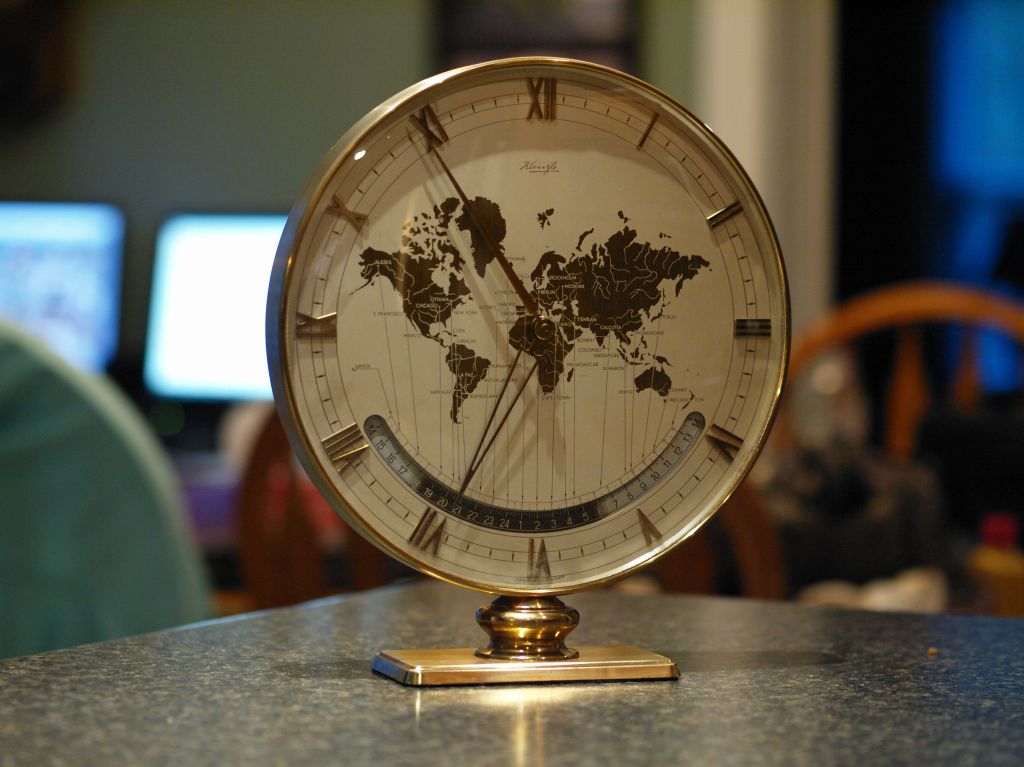This clock stands out as one of the most distinctive pieces in my collection. At first glance, it appears to be an ordinary desk clock, but it has a fascinating history behind its production. I can easily picture it sitting on the desk of an import-export executive in the 1950s.

The first Kienzle World Time clock was given to Adolf Hitler on his 50th birthday in 1939 by the government of Württemberg. The clock featured a classic design with a world map in the “Mercator” cylindrical map projection style and a rotating scale displaying the time in various cities. It was designed by Heinrich Johannes Möller, a renowned designer working for Kienzle from 1931 to 1970. Möller was hired at the age of 27 and became the principal designer at Kienzle.
The original clock had a bulky base and was adorned with a controversial pattern around the bezel. I have a photo of the original clock, but I chose not to share it due to the presence of swastika symbols on the clock. The swastika is now widely associated with hate and discrimination.
After the war, the design was updated: the decorations were removed, and the base was reduced in size, while the overall layout of the dial remained consistent across different versions of the clock. These versions ranged from early mechanical models to electro-mechanical versions and, eventually, quartz movements in the 1980s.
An interesting aspect of the clock is that it originally positioned Germany at the center of the world. In its update, the area around the center cannon shows North Africa.

The World Time Clock, also known as the Weltzeituhr model, was a long-running product available for purchase until Kienzle’s bankruptcy in 1996. When the World Time Clock was first introduced in 1939, Kienzle employed over 6,500 people and produced 5 million clocks annually.

In the late 1950s and 1960s, Kienzle clocks shifted away from their original stylistic prominence and began to follow contemporary international design trends. Despite this shift, Heinrich Johannes Möller continued to play a key role, influencing not only the design of Kienzle clocks but also the broader world of clock design.
Mechanical clocks are highly valued and sought after by collectors due to their craftsmanship and traditional design. These versions are typically considered more valuable than modern electromechanical and quartz alternatives.
Discover more from Antique and Vintage Clocks
Subscribe to get the latest posts to your email.

Interestingly, the 4 is IV and not IIII. I wonder why…
LikeLike
Sorry for the delayed response, Kevin. My wife and I recently got back from the UK. During our trip, an important family issue came up, causing the blog to take a back seat. Yes, unusual to see the 4 represented in that way. The number four is represented differently on clock dials, often using “IIII” instead of the traditional Roman numeral “IV,” for several reasons: using “IIII” instead of “IV” creates a more balanced and visually pleasing look on the clock face. It ensures symmetry, especially when the numerals are arranged around the dial. Historically, many early clocks used “IIII” as it was a common practice before standardizing Roman numerals. Some would suggest that “IIII” can make the clock easier to read. In some cases, using “IIII” instead of “IV” simplifies the manufacturing process. All the numerals on the clock face are created using fewer different molds or stamps, reducing production complexity.
Ron
LikeLike